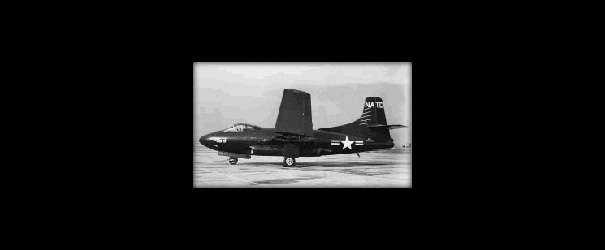
The Douglas F3D SkyNight
Note: Want to see one locally? A neighborhood park one mounted on a
raised platform next to Woodruff, between Carson and Del Amo.
At the end of WWII there was a convergence of new technologies - jet propulsion, air-to-air guided missiles, and capable airborne radars. And at the same time, there was the emerging recognition of a new global threat to the United States - a confrontation between the east and west.
Late in 1945, the Navy saw a need for a carrier-capable night fighter and asked Grumman, Fleetwings, and Douglas to propose designs to fill this concept. The requirements were for a two-seat aircraft to be able to identify a target flying at 40,000 ft at 500 mph at a distance of 125 miles and then engage it with new guided missiles. In April of 1946, the Navy ordered prototypes from Grumman (XF9F-1) and from Douglas (XF3D-1). The Grumman offering eventually evolved into the single-seat Panther day fighter, while the XF3D Skyknight took on the role of the first jet night fighter able to operate from the deck of an aircraft carrier. Design and development of the XF3D was undertaken at the El Segundo Division, with Ed Heinemann in the lead role.
On March 23 1948, with Russ Thaw at the controls, the first XF3D-1 made its maiden flight from Mines Field. That plane, along with two others, demonstrated the suitability of the type in a test program at Edwards Air Force Base during the fall of that year.
Douglas received its first order for 28 F3D-1s for the Navy and Marine Corps. The first production ship (BuNo 123741) flew on February 13. 1950, and the type entered US Navy and Marine Corps service early in 1951.
Follow-on orders of the Skyknight program were for the F3D-2. Improvements for this version included electronic system upgrades and an autopilot, a more rugged windshield, and wing spoilers. The -2 was scheduled to be fitted with Westinghouse J46 engines with 4,500 lbs of thrust, but that engine had technical problems so severe that the 3,400-lb-thrust J34s, which powered the prototypes and the initial production batch of the fighter, was retained for the F3D-2 even through the planned performance upgrades were sacrificed.
A swept wing version of the Skyknight, the F3D-3, was planned. This version would have utilized the J46, but with the discontinuation of the engine program, there was insufficient performance improvement to justify the production and an order for 287 -3s was cancelled.
In September 1962, the F3D-2 was redesignated F-10B under the new Tri-Service unified designation system. The F3D-2M (Sparrow missile-armed) became MF-10B, the F3D-2Q (electronc countermeasure) became EF-10B, and the F3D-2T2 trainer became TF-10B.
The performance of the Skyknight was never very impressive, and, following the end of the Korean War, the F3Ds were rapidly replaced in Navy frontline service by more advanced single-seat types such as the F4D Skyray. The Navy Skyknights were then relegated to training and experimental roles.
A total of 268 of the Douglas night fighters were built. The final ship was delivered on March 23, 1952.
The Skyknight remained active with the Marine Corps for somewhat longer than it did with the Navy. By the time of Vietnam, EF-10Bs electronic countermeasures aircraft were still serving with VMCJ-1, -2, and -3. They flew tactical jamming and ferret missions out of Da Nang with VMCJ-1 in support of strike aircraft attacking targets in North Vietnam. The last Marine Corps EF-10Bs were retired in May of 1970.

